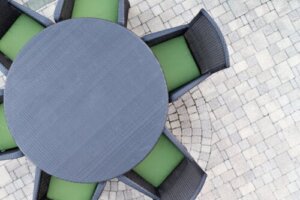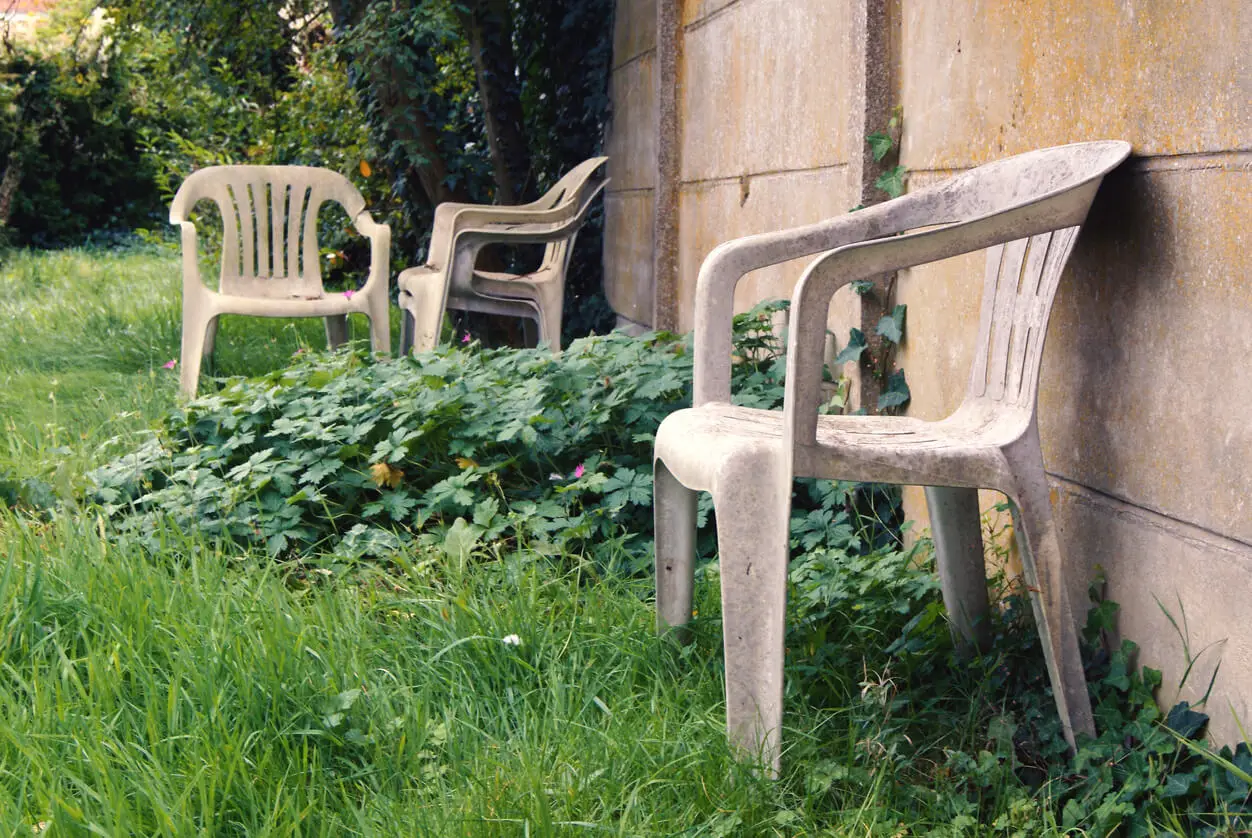How to Clean and Care for Plastic Garden Furniture

If you don’t quite know how to clean and take care of your plastic garden furniture, we invite you to read this article to the end to learn what you can and can’t do. We know that this furniture is a favorite when it comes to choosing patio furniture, as it’s very durable and requires little maintenance.
The most common models are the white plastic ones, which are often placed near a pool, on a terrace, and in other outdoor spaces. However, during the winter, they’re often not used much, so they tend to accumulate dirt and grime.
If they’re not cleaned often, they get damaged and even seem to have changed color. Bearing this in mind, let’s review how we can restore them to like-new condition.
Why clean plastic?
During the spring and summer, garden furniture stays clean because we use it often. However, when the days get colder, we stop using it. Therefore, we often don’t clean them regularly.
It’s during this time when the dirt accumulates and we have to do a deeper cleaning.
Also, because it’s made of plastic, this type of furniture is very resistant to different weather conditions and ultraviolet (UV) rays. However, when it’s exposed to the sun for a long time, it can crack and discolor.
That’s why we suggest that you protect it when it’s not in use.
Finally, remember that plastic is a porous material that causes this type of furniture to accumulate germs. They will proliferate thanks to the remains of organic material, such as food waste.
The best tips and methods to care for plastic furniture
Now we’ll dive into the best ideas to protect your plastic furniture. You will be able to enjoy your furniture for a long time if you follow these tips.

Method 1: Detergent, acetone, and baking soda to clean plastic garden furniture
This trio is infallible when it comes to deep cleaning. Each one does its part, and together they will make your plastic furniture look as good as new. You will need 100 ml of dishwashing detergent, one tablespoon of baking soda, and 100 ml of acetone.
Mix the three ingredients in a bowl well. Then, we suggest you place the preparation in a container with a spray bottle to make its application easier and more effective.
Next, spray the furniture with this liquid and rub the surface with a rough sponge. Once the sponge has been wiped over all the nooks and crannies of chairs and tables, rinse with plenty of water.
If there are stubborn stains, leave the mixture on for 15 minutes before removing the product. Similarly, if they don’t come out, moisten a cotton swab with acetone and wipe it over the stain.
This can always be done with white plastic furniture. If yours are a different color, first do a test on an inconspicuous area, just in case.
Method 2: Coconut soap, baking soda, and hydrogen peroxide
In this case, we are going to replace the detergent with coconut soap and the acetone with hydrogen peroxide. As you will see, baking soda is a constant, and you can’t do without it. Why? Because its granulated texture works as an excellent exfoliant in addition to being a good whitener.
The proportions are the same as in point 1, as is the preparation method. In this case, leave the product to act for half an hour before rinsing.
We think you may be interested in reading this, too: How to Use Neem Oil to Look After Your Garden Plants
Method 3: White vinegar, baking soda, and dishwasher
For this third alternative, you will use 100 ml of detergent, 100 ml of vinegar, 100 ml of water, and one tablespoon of baking soda. The way to apply is the same as the two previous methods. Remember that the sponge that you use must be rough.
Method 4: Ammonia
In this case, you’ll dilute ammonia in warm water and add detergent. It’s important not to mix products such as bleach, alcohol, or ammonia, but use them separately.
Regardless of how you choose to clean the furniture, it’s essential to wear gloves and safety goggles, if necessary.
Plastic furniture benefits by the action of baking soda thanks to its bleaching power.
Method 5: A high-pressure cleaner
This method never fails, because the pressure exerted by the water on the furniture helps to remove virtually all traces of dirt. If you notice that the dirt and stains don’t come off, you can first try some of the previous methods and then remove the details with this machine.
Like this article? You may also like to read: The Best Trees and Shrubs for Privacy in the Garden
Cleaning and caring for plastic garden furniture is possible
So far, we’ve presented you with different ways to clean and care for plastic garden furniture. During the warmer months, it’s best to clean your future after each use to prevent dirt from accumulating.
Try to store your table and chairs indoors, or at least cover them with a tarp, to keep them out of direct sunlight when not in use. In short, don’t leave them outdoors to prevent any type of damage that climatic factors may cause.
All cited sources were thoroughly reviewed by our team to ensure their quality, reliability, currency, and validity. The bibliography of this article was considered reliable and of academic or scientific accuracy.
- ANÍBAL, J., PEDROZO, C. A., FEDERICO, N., & SOLER RUIZ, J. E. A. PRODUCCION DE AMONIACO.
- HUMANA, C. P. D. E., & AMBIENTE, S. D. D. S. Y. (1989). GUÍA PARA LA SALUD Y LA SEGURIDAD.
- Galván Sánchez, V. A., Gutiérrez Robles, J. A., Ortiz Muro, V. H., & Sánchez Herrera, R. (2012). Los muebles de plástico de la pierna niveladoresalta frecuencia. Ingeniería Energética, 33(2), 122-132.
- Galván Sánchez, V. A., Gutiérrez Robles, J. A., Ortiz Muro, V. H., & Sánchez Herrera, R. (2012). (J987) los muebles de plástico ajustable de alta calidad de la piernaalta frecuencia. Ingeniería Energética, 33(2), 122-132.
- Valencia Rubiano, J. S. (2020). Estudio de factibilidad para la creación de una empresa fabricadora de muebles modulares a partir de plástico reciclado en la ciudad de Pereira.
- Campos, C. E. (2008). Diseñar con plástico. MaoMao Publications.
This text is provided for informational purposes only and does not replace consultation with a professional. If in doubt, consult your specialist.








